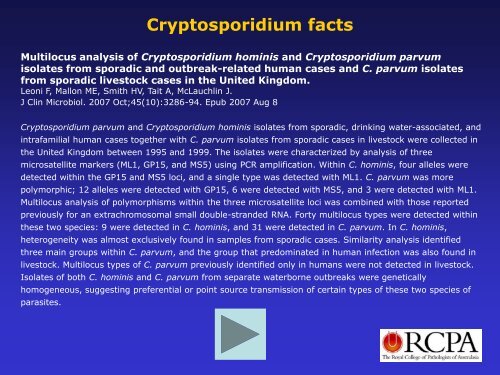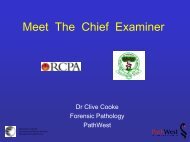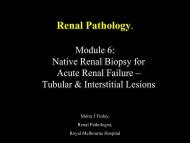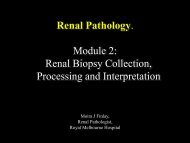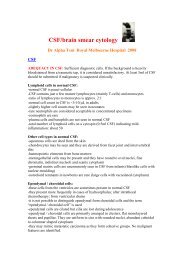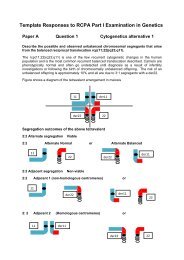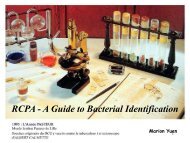Vomiting & Diarrhoea in a nursing home - Rcpa.tv
Vomiting & Diarrhoea in a nursing home - Rcpa.tv
Vomiting & Diarrhoea in a nursing home - Rcpa.tv
Create successful ePaper yourself
Turn your PDF publications into a flip-book with our unique Google optimized e-Paper software.
Cryptosporidium facts<br />
Multilocus analysis of Cryptosporidium hom<strong>in</strong>is and Cryptosporidium parvum<br />
isolates from sporadic and outbreak-related human cases and C. parvum isolates<br />
from sporadic livestock cases <strong>in</strong> the United K<strong>in</strong>gdom.<br />
Leoni F, Mallon ME, Smith HV, Tait A, McLauchl<strong>in</strong> J.<br />
J Cl<strong>in</strong> Microbiol. 2007 Oct;45(10):3286-94. Epub 2007 Aug 8<br />
Cryptosporidium parvum and Cryptosporidium hom<strong>in</strong>is isolates from sporadic, dr<strong>in</strong>k<strong>in</strong>g water-associated, and<br />
<strong>in</strong>trafamilial human cases together with C. parvum isolates from sporadic cases <strong>in</strong> livestock were collected <strong>in</strong><br />
the United K<strong>in</strong>gdom between 1995 and 1999. The isolates were characterized by analysis of three<br />
microsatellite markers (ML1, GP15, and MS5) us<strong>in</strong>g PCR amplification. With<strong>in</strong> C. hom<strong>in</strong>is, four alleles were<br />
detected with<strong>in</strong> the GP15 and MS5 loci, and a s<strong>in</strong>gle type was detected with ML1. C. parvum was more<br />
polymorphic; 12 alleles were detected with GP15, 6 were detected with MS5, and 3 were detected with ML1.<br />
Multilocus analysis of polymorphisms with<strong>in</strong> the three microsatellite loci was comb<strong>in</strong>ed with those reported<br />
previously for an extrachromosomal small double-stranded RNA. Forty multilocus types were detected with<strong>in</strong><br />
these two species: 9 were detected <strong>in</strong> C. hom<strong>in</strong>is, and 31 were detected <strong>in</strong> C. parvum. In C. hom<strong>in</strong>is,<br />
heterogeneity was almost exclusively found <strong>in</strong> samples from sporadic cases. Similarity analysis identified<br />
three ma<strong>in</strong> groups with<strong>in</strong> C. parvum, and the group that predom<strong>in</strong>ated <strong>in</strong> human <strong>in</strong>fection was also found <strong>in</strong><br />
livestock. Multilocus types of C. parvum previously identified only <strong>in</strong> humans were not detected <strong>in</strong> livestock.<br />
Isolates of both C. hom<strong>in</strong>is and C. parvum from separate waterborne outbreaks were genetically<br />
homogeneous, suggest<strong>in</strong>g preferential or po<strong>in</strong>t source transmission of certa<strong>in</strong> types of these two species of<br />
parasites.


